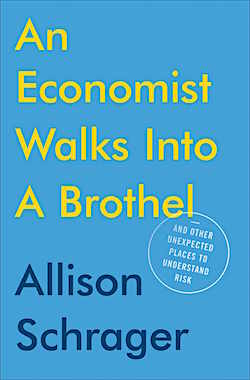
Allison Schrager has written a book about risk-taking that is by turns delightful, instructive, irreverent and wise. She draws on the basic principles of modern financial theory to illuminate the ways in which we can deal sensibly with risk in everyday (and not so everyday) situations. Conversely, she uses these quotidian examples to illustrate the basic maxims of finance.
The book opens with a fascinatingly kinky chapter on the risks to sex workers and clients in the legally sanctioned brothels of Nevada. The risks to the women of abuse or death is reduced by the open, legal and regulated nature of the business, and the risk of STDs to both them and their clients is reduced by regular and frequent testing.
But their reduced risk entails relatively lower pay. Lawful sex workers can’t demand as much as call girls, who wouldn’t work in unregulated and illegal settings unless they got paid enough to offset the added risk. This chapter illustrates, among other things, the basic principle that there’s a correspondence between risk and reward.
A subsequent chapter on horse-breeding—like all the chapters in the book, worth reading simply for its clear account of some key facets of an arcane or offbeat industry—illustrates the importance of diversification, as well as the risk–reward relationship. (Incidentally, do readers know what a “teaser horse” is? Hint: It’s not a mare.)
Thoroughbred breeders with the foal of a famous money-earning sire face a critical decision when the horse reaches the age of two. They can sell it for a reasonable price, or they can hold on until it reaches age three and starts to race. If a colt turns out to be a champion, they can reap huge profits. The earnings and more importantly the stud fees of champion stallions can be spectacular. However, this is a huge gamble. Many thoroughbreds are called but few are chosen. The author observes that breeders do not diversify their risk sufficiently—they should engage in cross-breeding to encourage gene diversity. Instead, they tend to bet big on a handful of long-shots.
I was also struck by the remark, which the author attributes to Warren Buffett, that diversification is protection against ignorance, not a strategy for superstar investors. I would take issue with that. Even superstar investors have to recognize the risk-return relationship. I also wonder why the techniques of superstars cannot be replicated. Do they possess state secrets? Could it be—perish the thought—that the Sage of Omaha simply has “hot hands?” Do economies of scale significantly reduce the costs of his operations?
As an illustration of moral hazard, Schrager’s chapter on big wave surfing is a tour de force. Surfers are organized and hold technically-oriented meetings that address risk reduction and the role of the latest surfing and related technology. The comparison between the meetings held by surfers and those of pension and retirement industry geeks is hilarious.
A vital risk-reward tradeoff is present when a surfer has to decide whether to take the first in a series of waves—it’s the biggest but also the most dangerous. Moral hazard arises because the invention and use of jet skis in bringing rescuers to downed surfers has also increased the propensity for surfers to take on more risks. An important parallel is drawn between surfing and financial derivatives, which do provide a form of insurance, but which have become forbiddingly complex and may promote excessive risk-taking. Similarly, “safer” cars have apparently led to more if less fatal accidents.
Other chapters illustrate the importance of taking calculated risks, and of recognizing the link between one’s irrational tendencies and excessive risk-taking. Schrager also points out the role of basic uncertainty, when the probabilities of success or failure cannot be calculated. The chapter on the “fog of war” is particularly instructive in this respect. It emphasizes the need for flexibility: in war, that means allowing commanders in the field to move to Plan B if Plan A isn’t working. This point is illustrated with a gripping account of now General H.R. McMaster’s successful offensive during the Gulf War.
This book has an honored place on my bookshelf. I hope it will find its way unto the book shelves of many readers of this review.
© 2019 RIJ Publishing LLC. All rights reserved.

